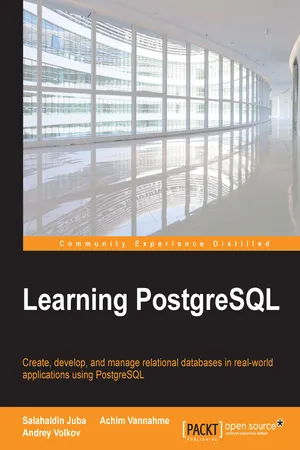
- 464 pages
- English
- ePUB (mobile friendly)
- Available on iOS & Android
Learning PostgreSQL
About This Book
Create, develop and manage relational databases in real world applications using PostgreSQL
About This Book
- Learn about the PostgreSQL development life cycle including its testing and refactoring
- Build productive database solutions and use them in Java applications
- A comprehensive guide to learn about SQL, PostgreSQL procedural language and PL/pgSQL
Who This Book Is For
If you are a student, database developer or an administrator, interested in developing and maintaining a PostgreSQL database, then this book is for you. No knowledge of database programming or administration is necessary.
What You Will Learn
- Learn concepts of data modelling and relation algebra
- Install and set up PostgreSQL database server and client software
- Implement data structures in PostgreSQL
- Manipulate data in the database using SQL
- Implement data processing logic in the database with stored functions, triggers and views
- Test database solutions and assess the performance
- Integrate database with Java applications
- Detailed knowledge of the main PostgreSQL building objects, most used extensions
- Practice database development life cycle including analysis, modelling, (documentation), testing, bug fixes and refactoring
In Detail
PostgreSQL is one of the most powerful and easy to use database management systems. It has strong support from the community and is being actively developed with a new release every year. PostgreSQL supports the most advanced features included in SQL standards. Also it provides NoSQL capabilities, and very rich data types and extensions. All that makes PostgreSQL a very attractive solution in various kinds of software systems.
The book starts with the introduction of relational databases with PostegreSQL. It then moves on to covering data definition language (DDL) with emphasis on PostgreSQL and common DDL commands supported by ANSI SQL. You will then learn the data manipulation language (DML), and advanced topics like locking and multi version concurrency control (MVCC). This will give you a very robust background to tune and troubleshoot your application. The book then covers the implementation of data models in the database such as creating tables, setting up integrity constraints, building indexes, defining views and other schema objects. Next, it will give you an overview about the NoSQL capabilities of PostgreSQL along with Hstore, XML, Json and arrays. Finally by the end of the book, you'll learn to use the JDBC driver and manipulate data objects in the Hibernate framework.
Style and approach
An easy-to-follow guide to learn programming build applications with PostgreSQL, and manage a PostgreSQL database instance.
Frequently asked questions
Information
Learning PostgreSQL
Table of Contents
Table of contents
- Learning PostgreSQL